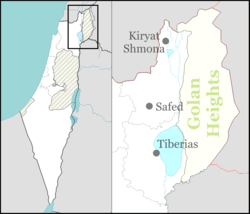Amir, Israel
| Amir | |
|---|---|
_-_Kibbutz_Amir.jpg) | |
 Amir | |
| Coordinates: 33°10′42.24″N 35°37′14.88″E / 33.1784000°N 35.6208000°ECoordinates: 33°10′42.24″N 35°37′14.88″E / 33.1784000°N 35.6208000°E | |
| Council | Upper Galilee |
| Affiliation | Kibbutz Movement |
| Founded | 29 October 1939 |
| Founded by | Lithuanian and Polish immigrants |
| Population (2015)[1] | 542 |
Amir (Hebrew: עָמִיר, lit. Sheaf) is a kibbutz in northern Israel. Located in the Finger of the Galilee near Kiryat Shmona, it falls under the jurisdiction of Upper Galilee Regional Council. In 2015 it had a population of 542. The kibbutz is on the eastern bank of the Jordan River in the Hula Valley, and has views of snow-topped Mount Hermon to the northeast, and the Ramat Naftali to the west.
History
Kibbutz Amir was established on 29 October 1939 on land purchased by the Jewish National Fund from the Arab village of Khiyam al-Walid. It was the last of the tower and stockade settlements, and the only one to be established during World War II.[2] Its founders were immigrants from Lithuania and Poland, later joined by German and Yugoslav settlers.[3] Initially they suffered from outbreaks of malaria, but managed to establish an intensively cultivated farm. According to a 1949 report from the Jewish National Fund, a clinic was opened at Amir for the treatment of malaria and eye diseases by a professor from Hebrew University. Until the beginning of the 1948 Arab-Israeli war treatment there for neighboring Arab villagers was free.[3]
A photo in the June 1940 edition of Life Magazine shows a kibbutz member plowing the heavy soil with a primitive plow pulled by two water buffalo. Due to its location, the kibbutz was affected by floods every winter, and in 1942 was moved to its present location on land bought from another Arab village, al-Dawwara.
A disposable diaper factory, Tafnukim, owned by the kibbutz was privatized in 2003.[4] On July 15, 2006, a missile fired from Lebanon hit Kibbutz Amir, setting fire to the factory,[5] which is located about 400 meters from the kibbutz residences. The attack was on Saturday when the factory was closed. Four days later, a missile hit a cow shed, killing two dozen dairy cows.[6]
Notable residents
Several important women artists are associated with Kibbutz Amir. Israeli jewelry artist Deganit Stern Schocken was born at Kibbutz Amir in 1947; she now teaches and works in Hadera. Israeli ceramicist, designer and filmmaker Shlomit Bauman was born at Kibbutz Amir in 1962; she now lives and works in Jaffa. American photographer Annie Leibovitz worked as a volunteer at Kibbutz Amir in 1969, and gelatin silver prints of her photos taken during her stay are now part of the collection of the Jewish Museum in New York.
References
- ↑ "List of localities, in Alphabetical order" (PDF). Israel Central Bureau of Statistics. Retrieved 16 October 2016.
- ↑ HaReuveni, Immanuel (1999). Lexicon of the Land of Israel (in Hebrew). Miskal - Yedioth Ahronoth Books and Chemed Books. p. 766. ISBN 965-448-413-7.
- 1 2 Jewish National Fund (1949). Jewish Villages in Israel. Jerusalem: Hamadpis Liphshitz Press. p. 5.
- ↑ Sano to make bid for troubled local diaper maker Tafnukim
- ↑ Setting fire to the factory
- ↑ Kibbutzim in Line of Fire in North Israel